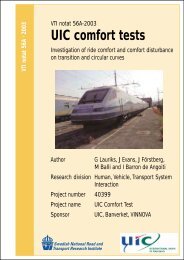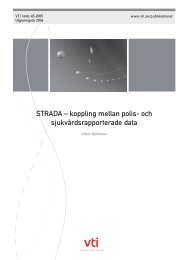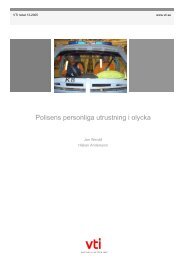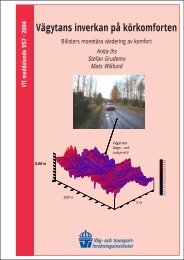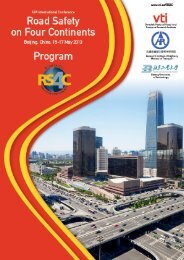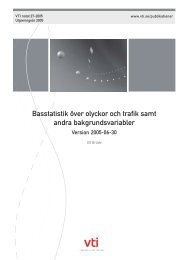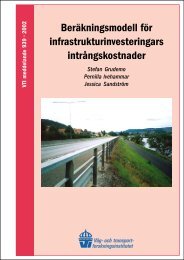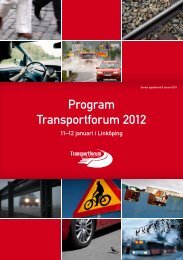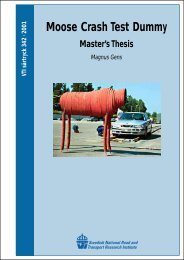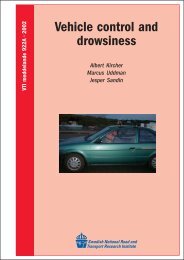Create successful ePaper yourself
Turn your PDF publications into a flip-book with our unique Google optimized e-Paper software.
Publisher:<br />
Publication:<br />
<strong>VTI</strong> rapport 775<br />
Published:<br />
2013<br />
Project code:<br />
200878<br />
Dnr:<br />
2012/0596-28<br />
SE-581 95 Linköping Sweden Project:<br />
Low traffic volume roads - State-of-the-art<br />
Author: Sponsor:<br />
Karin Edvardsson <strong>VTI</strong><br />
Title:<br />
Low traffic volume roads - A literature review concerning benefit, standard, condition, operation, and<br />
maintenance<br />
Abstract<br />
In all the Nordic countries unbound or thin sealed road surfaces are common. Low traffic volume roads<br />
include all roads with a traffic volume of up to 1,000 vehicles per day. Approximately 75% of the total<br />
Swedish government administered road network is low volumed. For the municipal road network, the<br />
corresponding figure is 70%. In addition, the whole private road network, which is much larger in length<br />
than the government and municipal administered road networks together, is low volumed. Low traffic<br />
volume roads have low traffic intensity but it may be noted that it is the same people who often use the<br />
roads and therefore incur increased operating costs and reduced comfort.<br />
In summary, a large amount of literature in the area treats condition measurements and reinforcement,<br />
particularly methods for these. However, there is not much research on the actual road network status,<br />
degradation models and life cycle costs published.<br />
The structural condition of the road is the most critical parameter for the asset value of the low traffic<br />
volume road network. Road capacity affects accessibility for freight transports and is therefore of great<br />
importance to the forest industry.<br />
Degradation of low traffic volume roads is more complex than on heavily trafficked roads where traffic<br />
is the most important parameter. At low traffic volume roads, there is a longer time horizon as well as the<br />
fact that several parameters, such as the aging, durability, and climate interact. However, the life length<br />
of a road increases significantly when the drainage is improved.<br />
Operation and maintenance of low traffic volume roads can generally be divided into the four areas; 1)<br />
winter operation, 2) management of the functional condition of the road during the period when the<br />
ground is free from frost, 3) management of the road's structural condition, and 4) management during<br />
the spring thaw period. In the future, a fifth area may be climate adaption, as mentioned in recent EU<br />
statements. New technologies for condition measurements will play a major role in maintenance and<br />
improvement of the aging of low traffic volume road network.<br />
When it comes to low traffic volume roads, it is very difficult to find economic motives to justify a good<br />
condition of these roads. However, these roads must have a minimum acceptable standard, a so called<br />
"shame limit", which at least allows people to get to and from home/work safely.<br />
Keywords:<br />
Low traffic volume roads, functional condition, structural condition, operation and maintenance.<br />
ISSN: Language: No. of pages:<br />
0347-6030 Swedish 78 + Appendix



